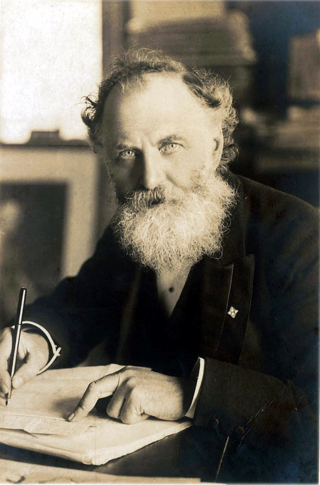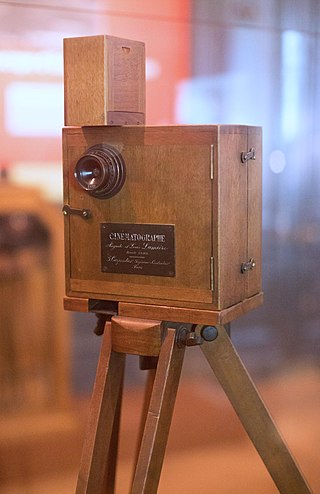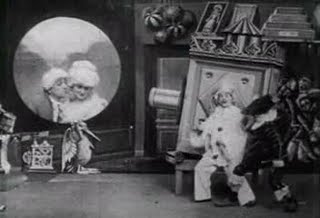Related Research Articles

The magic lantern, also known by its Latin name lanterna magica, was an early type of image projector that used pictures—paintings, prints, or photographs—on transparent plates, one or more lenses, and a light source. Because a single lens inverts an image projected through it, slides were inserted upside down in the magic lantern, rendering the projected image correctly oriented.

William Thomas Stead was an English newspaper editor who, as a pioneer of investigative journalism, became a controversial figure of the Victorian era. Stead published a series of hugely influential campaigns whilst editor of The Pall Mall Gazette, including his 1885 series of articles, The Maiden Tribute of Modern Babylon. These were written in support of a bill, later dubbed the "Stead Act", that raised the age of consent from 13 to 16.

Precursors of film are concepts and devices that have much in common with the later art and techniques of cinema.

Max Skladanowsky was a German inventor and early filmmaker. Along with his brother Emil, he invented the Bioscop, an early movie projector the Skladanowsky brothers used to display a moving picture show to a paying audience on 1 November 1895, shortly before the public debut of the Lumière Brothers' Cinématographe in Paris on 28 December 1895.

The Museum of Precinema is a museum in the Palazzo Angeli, Prato della Valle, Padua, Italy, related to the history of precinema, or precursors of film. It was created in 1998 to display the Minici Zotti Collection, in collaboration with the Comune di Padova. It also produces interactive touring exhibitions and makes valuable loans to other prestigious exhibitions such as 'Lanterne magique et film peint' at the Cinémathèque Française in Paris and the Museum of Cinema in Turin.

A projector or image projector is an optical device that projects an image onto a surface, commonly a projection screen. Most projectors create an image by shining a light through a small transparent lens, but some newer types of projectors can project the image directly, by using lasers. A virtual retinal display, or retinal projector, is a projector that projects an image directly on the retina instead of using an external projection screen.
Edmé-Gilles Guyot (1706–1786) was a French mail clerk, physician, postmaster, cartographer, inventor and author on the subject of mathematics, physics and magic. He experimented with optical illusions and with the theory behind performance magic. His developments into the apparent appearance of ghosts, using the projection of a figure into smoke, helped to create the technology and techniques used in phantasmagoria.

Agnes Deans Cameron was a Canadian educator, travel writer, journalist, lecturer, and adventurer. She was the first white woman to reach the Arctic Ocean and her published book about the journey was a best-seller. She promoted immigration to Canada through her lectures and publications.

The history of film technology traces the development of techniques for the recording, construction and presentation of motion pictures. When the film medium came about in the 19th century, there already was a centuries old tradition of screening moving images through shadow play and the magic lantern that were very popular with audiences in many parts of the world. Especially the magic lantern influenced much of the projection technology, exhibition practices and cultural implementation of film. Between 1825 and 1840, the relevant technologies of stroboscopic animation, photography and stereoscopy were introduced. For much of the rest of the century, many engineers and inventors tried to combine all these new technologies and the much older technique of projection to create a complete illusion or a complete documentation of reality. Colour photography was usually included in these ambitions and the introduction of the phonograph in 1877 seemed to promise the addition of synchronized sound recordings. Between 1887 and 1894, the first successful short cinematographic presentations were established. The biggest popular breakthrough of the technology came in 1895 with the first projected movies that lasted longer than 10 seconds. During the first years after this breakthrough, most motion pictures lasted about 50 seconds, lacked synchronized sound and natural colour, and were mainly exhibited as novelty attractions. In the first decades of the 20th century, movies grew much longer and the medium quickly developed into one of the most important tools of communication and entertainment. The breakthrough of synchronized sound occurred at the end of the 1920s and that of full color motion picture film in the 1930s. By the start of the 21st century, physical film stock was being replaced with digital film technologies at both ends of the production chain by digital image sensors and projectors.
Henry Langdon Childe (1781–1874) was an English showman, known as a developer of the magic lantern and dissolving views, a precursor of the dissolve in cinematic technique. While the priority question on the technical innovations Childe used is still debated, he established the use of double and triple lanterns for special theatrical effects, to the extent that the equipment involved became generally available through suppliers to other professionals. By the 1840s the "dissolving view", rooted in Gothic horror, had become a staple of illustrated talks with restrained animations.

Charles Barker Howdill (1863–1941) was a Leeds architect and photographer, who travelled extensively on the European continent before the First World War and gave hundreds of illustrated magic lantern lectures about his journeys. Howdill was among the first to exhibit colour photographs at the Royal Photographic Society, beginning in 1901.
Events in 1941 in animation.

La Lanterne magique, sold in the United States as The Magic Lantern and in Britain as The Magic Lantern, or the Bioscope in the Toy Shop, is a 1903 French silent trick film by Georges Méliès. It was sold by Méliès's Star Film Company and is numbered 520–524 in its catalogues.
Events in 1912 in animation.
Events in 1891 in animation.
Events in 1884 in animation.
Events in 1874 in animation.
Events in 1862 in animation.
Events in 1860 in animation.
Events in 1855 in animation.
References
- ↑ The Illustrated London News. Illustrated London News & Sketch Limited. 1863. p. 19.
- ↑ Donald Crafton; Before Mickey: The Animated Film, 1898-1928; University of Chicago Press; ISBN 0-226-11667-0 (2nd edition, paperback, 1993)
- ↑ Denis Gifford; American Animated Films: The Silent Era, 1897-1929; McFarland & Company; ISBN 0-89950-460-4 (library binding, 1990)
- ↑ Leonard Maltin; Of Mice and Magic: A History of American Animated Cartoons; Penguin Books; ISBN 0-452-25993-2 (1980, 1987)
- ↑ "From the Archives: W. R. Hearst, 88, Dies in Beverly Hills" Archived December 15, 2019, at the Wayback Machine (original pub. August 15, 1951). Los Angeles Times. Retrieved from LATimes.com September 15, 2018.
- ↑ Barber, Stephen (2010-10-11). "The Skladanowsky Brothers: The Devil Knows". Senses of Cinema. Retrieved 2020-03-22.
- ↑ "Who's Who of Victorian Cinema". www.victorian-cinema.net. Retrieved 2020-03-22.
- ↑ Hale, Linda L. (1998). "Agnes Deans Cameron". Dictionary of Canadian Biographies. Vol. XIV (1911-1920). University of Toronto/Laval University. Retrieved 16 July 2015.
- ↑ Cameron, Agnes Deans (1909). The New North: Being Some Account of a Woman's Journey through Canada to the Arctic. New York: D. Appleton. Retrieved 16 July 2015.
- ↑ "Cameron, Agnes Deans (1863-1912)". ABC Book World. Retrieved 16 July 2015.
- ↑ Janet Douglas, Charles Barker Howdill: Historical Notes for the Blue Plaque Unveiling, Saturday 28 October 2018, Leeds: Leeds Civic Trust, p. 10.
- ↑ See Duncan McCargo "From Leeds to Jutland, About Leeds Blog, 28 July 2020". aboutleeds.blog. 28 July 2020. Retrieved 29 November 2020.
- ↑ Duncan McCargo (ed.) Jutland Jottings: Charles B. Howdill 1911, Copenhagen: Weysesgade eBooks 2020, p.3
- ↑ "W.T. Stead Image Gallery | W.T. Stead Resource Site". attackingthedevil.co.uk. Retrieved 6 April 2020.
- ↑ "Sisters : Charles Barker Howdill's Blazing Balkans". blazingbalkans.leeds.ac.uk. Retrieved 6 April 2020.